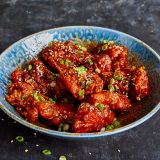To describe the options as endless doesn’t quite capture the reality of Seoul’s street food scene, a Technicolor and wildly aromatic cacophony of sizzling, searing, stir-frying, skewering and steaming that unfolds in tiny back alley pockets and sprawling markets at every turn across this city of nearly 10 million—dare I generalize—food-obsessed people.
There are skewers threaded with pork and chicken, which cooks blowtorch to charred perfection. There are chunks of sweet potatoes tossed in giant woks until lacquered with a sweet glaze. There are deep-fried baby crabs, deep-fried balls of cheese and noodles, deep-fried paper-thin dried squid. There are half-shell scallops grilled and topped with cheese. There are dumplings, steamed, fried or both. There are doughy-crisp cakes fried from mung beans ground on the spot.
And let me speak quite plainly here—that’s not even the beginning. But as you eat your way across the South Korean capital—a city of towering mirrored buildings and glowing electric signs piled one upon the other reaching skyward—the treat most often on repeat is fried chicken. Inordinate varieties, affectionately referred to as KFC. Korean fried chicken.
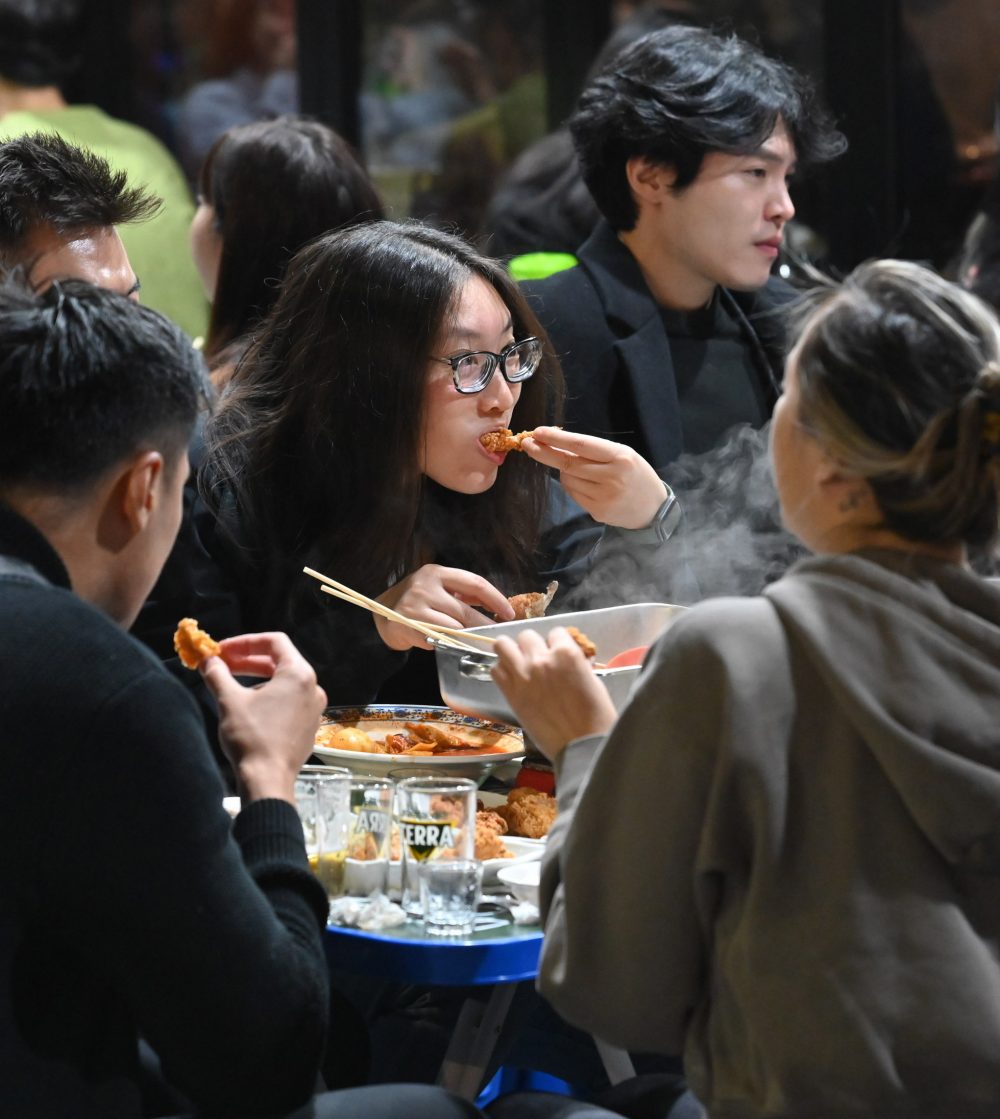
The vendors are clustered—some offer seating, others takeaway only—filling the air with a crackling savory aroma. Stands offering tongdak—whole chickens fried until snappishly crisp, what many consider the original style of Korean fried chicken—encompass an entire street. Elsewhere, there is more variety. Drumsticks. Thighs. Chunks. Gizzards. Tenders. Whole, but this time spatchcocked. Most of it slathered in bright, sticky sauces, the smaller pieces mounded into ice cream-style cups.
At the sit-down spots, men hunker around tiny tables, elbows competing for space with platters of fried chicken and its constant companions, robust bottles of Hite and Kloud beers. Most shops offer a selection of sauces, though all play off some pairing of sweet and heat, many infused with gochujang, the country’s ubiquitous fermented chili paste.
After considering dozens of choices for my first taste, I select Jangan Tong Dalk, the sort of shop where one wall holds a massive menu of chicken and beer options, the others are crowded with crates of beer. The tables are outfitted with three buttons, one each for ordering more chicken, beer or soju, a sweet Korean liquor that also frequents fried chicken joints.
We order an embarrassing flock, one of nearly everything on the menu, all of it fried to order. Whether whole or bits, the process mostly is the same. Raw chicken is dunked in a thin batter. Or rather, a slurry. Batter implies thickness, and this had almost none. From there, it goes immediately into a cauldron of oil. Flattened cardboard lines the floor to catch splashes.
The chicken fries for just a few minutes, then is scooped out with a massive mesh ladle. It rests for a bit on paper, then back into the oil for a few more minutes. From there, back onto paper, then into a large bowl where it is drenched and tossed with a sweet and spicy sauce of gochujang, garlic, sugar and spices.
Not to get all hyperbolic, but the taste is otherworldly. And the texture! The coating is ethereally thin, yet as satisfyingly crisp as the perfect potato chip. The meat is so moist I have to check myself. Was it fully cooked? It was! And that sauce ... It hits every note, high and low, in that maddeningly delicious way that keeps you going back for more.
All of which is to say, this is fried chicken that has leveled up. Many times over.
There are fried chicken traditionalists, the folks who swear allegiance to a buttermilk soak, heavy batters, heavy breading and even heavier frying. If that’s what you prefer, godspeed. I am not among those people.
I have a decidedly unorthodox approach to fried chicken. It’s an admittedly tedious affair in which naked chicken is seasoned and cooked low and slow via sous vide. Meltingly moist, it then is chilled, floured, egged, breaded and flash fried. Because the meat is cooked before it is coated and briefly fried, it never overcooks or becomes tough or sodden with oil.
But did I mention how tedious a process it is? Without question, it is amazing. And it works perfectly every time. The chicken I tasted in Seoul, however, surpassed it many times over. The meat was more moist and tender. The coating thinner and wildly crispier. And the whole affair was simpler and faster. I needed to know more.
Some historians say South Korea’s affinity for fried chicken can be traced back centuries, but most agree that it didn’t gain cultural traction until the 1970s, when both chicken and cooking oil became more affordable. A robust American military presence—itself heavily influenced by the fry-loving culinary traditions of the American South—undoubtedly played a part.
Today, it is the country’s most consumed fast food. In fact, by some counts, South Korea has more than 87,000 restaurants serving it. For anyone keeping track, that works out to roughly one eatery for every 598 people. That’s a lot of fried chicken.
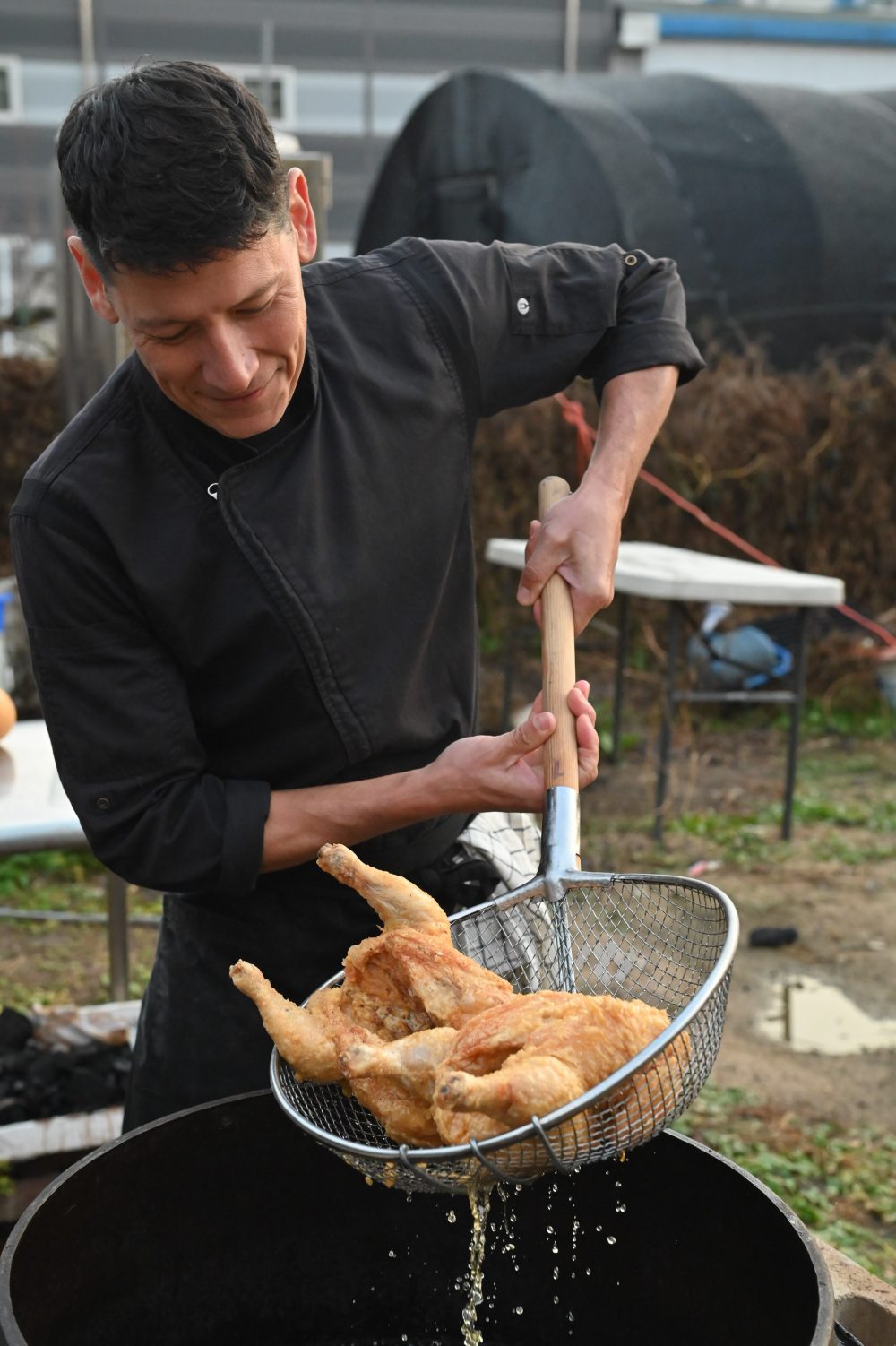
All of which brought me to Bear Foot Gardens, a ramshackle farm in Suwon, a city about 20 miles south of Seoul famous for an entire street dedicated to fried chicken restaurants. The farm is run by Ryan Phillips, a Korean-American chef raised in Texas—his father was adopted from South Korea—who came here about 20 years ago seeking a connection to his culinary heritage. Today, his farm supplies restaurants with ingredients less common in these parts. Think jalapeños.
“When I first came to Korea, KFC blew my mind. It was so crispy,” he explained. “The chicken is fried, then fried again. Then it is tossed with this sweet and savory sauce. It was incredible.”
He’d offered a lesson in Korean fried chicken, and it began with that slurry. When fried chicken caught hold here, wheat flour was pricey. Starch, whether potato or corn, was cheap. So breadcrumbs and flour dredges were out; starch-based, milk-thin slurries became the coating of choice. Those slurries—crepe batter thin—happen to fry up shatteringly, satisfyingly crisp.
The two-step frying method matters, too. To demonstrate, Phillips spatchcocked two whole chickens, splaying them open for even cooking. He dunked them into a simple slurry of starch and water, then plunged them into a massive pot of sizzling oil. After a bit, he plucked them out, cooling them on paper towels. Then back into the oil they went to finish cooking.
When they emerged a few minutes later, they seemed the Platonic form of fried chicken. Crisp, golden and visibly crunchy. Phillips doused them with a samyang sauce he whisked from sugary rice syrup, gochujang, gochugaru (Korean red pepper flakes), soy sauce and garlic. It was ... ridiculously good. The meat was impossibly moist and tender.
“You definitely want to have a beer with it,” he said as he tore hunks from one of the birds.
The double-frying is key. However one preps chicken prior to frying, once it’s in the oil, most of us tend to leave it there. The problem with that approach is that by the time the outside gets sufficiently crisped—it takes a while for the moisture to boil off as steam, thus allowing the coating to crisp—the meat can overcook.
But twice-frying upends that equation. Pulling the chicken out of the oil after an initial fry allows the meat to cool a bit. When it is returned to the oil, the exterior—which heats faster—is able to crisp perfectly with less risk of overcooking the meat. The result is moist, tender chicken with a wonderfully crisp coating.
But the slurry still had more to teach me. It turns out, it isn’t just a crispy coating. For chef Donill Keum, who bases much of his cooking on capturing the comfort his mother’s food gave him as a child, the slurry also is an opportunity to add flavor. Tons of it.
His recipe begins with a brief marinade, a mixture of sake, ginseng, turmeric, cumin, gochugaru, lemon juice, black pepper and salt, all of which he massages into the chicken. But that marinade does double duty. Adding a bit of all-purpose flour and cornstarch to it, he turns the marinade into the slurry, creating a richly, potently flavorful coating.
In and out, once and again, the chicken goes into the oil. It bubbles and sizzles, filling the kitchen with the seductive aroma and sound of frying. “When I deep-fry things, I want to hear a raining sound,” a metaphor I hear repeatedly. Tossed with a sauce of garlic, ketchup, gochugaru, gochujang, sugar and sake, his chicken is—forgive me—almost painfully good.
Sorry, but that is Korean fried chicken. It’s simple. It’s amazing. It changed the way I think about fried chicken.
Korean fried chicken is renowned for two delicious characteristics: a light, shatteringly crisp coating and meat that remains surprisingly tender and moist. Both are thanks to a cooking method that protects the meat from prolonged exposure to high heat while also giving the already light coating the time it needs to crisp and brown.
Unlike the fried chicken of the American South, Korean fried chicken isn’t dredged in wheat flour before frying. It instead is coated in a thin, very wet starchy slurry with the consistency of whole milk. And rather than one prolonged fry in the oil, it is fried twice for shorter durations, with a brief cooling-off period between them.
That slurry typically is made from potato starch or cornstarch, which are high in amylose starch, a variety that fries up particularly crisp. During frying, the wet slurry limits the temperature of the chicken to about the boiling point of water, keeping it from overcooking. The result is chicken that stays moist and tender.
The twice-fried method also plays a part. Pulling the chicken out of the oil briefly gives the meat a chance to cool. This allows for a second frying that ensures a crisp, golden coating without giving the meat inside a chance to overcook.
Korean Fried Chicken
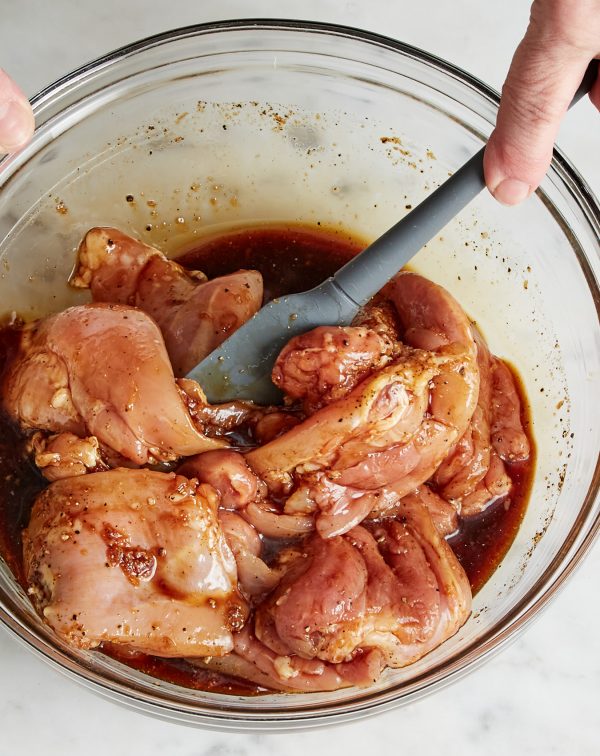
1. Add the chicken to the marinade and stir to coat. Cover and refrigerate for 30 to 45 minutes.
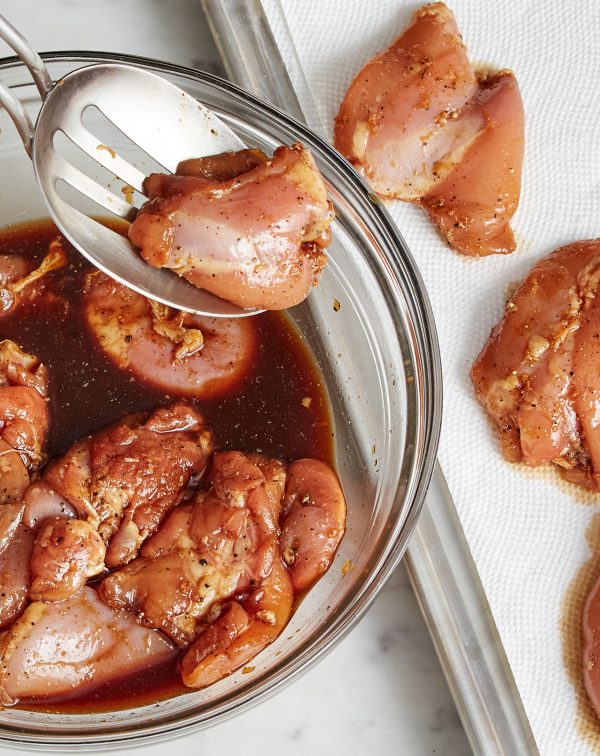
2. Use a slotted spoon to transfer the chicken to the prepared baking sheet, reserving the marinade.
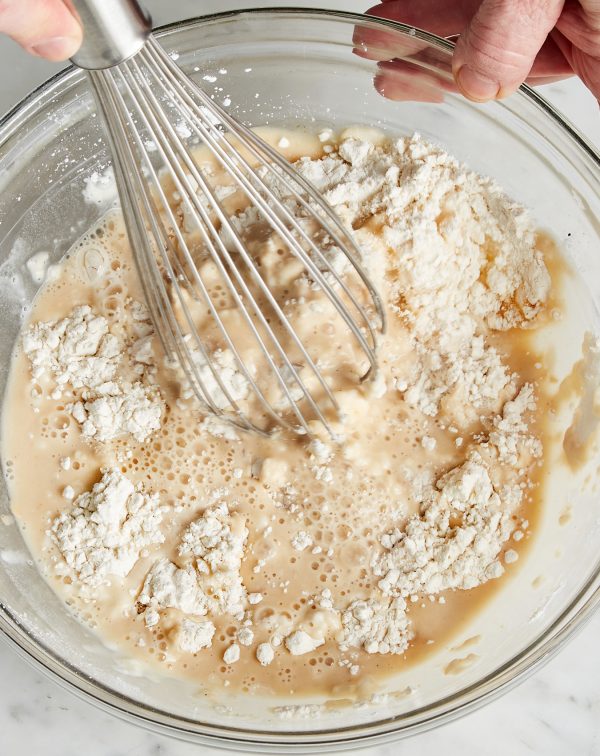
3. Whisk together the reserved marinade, cornstarch, flour and water. Add one-third of the chicken to the slurry.
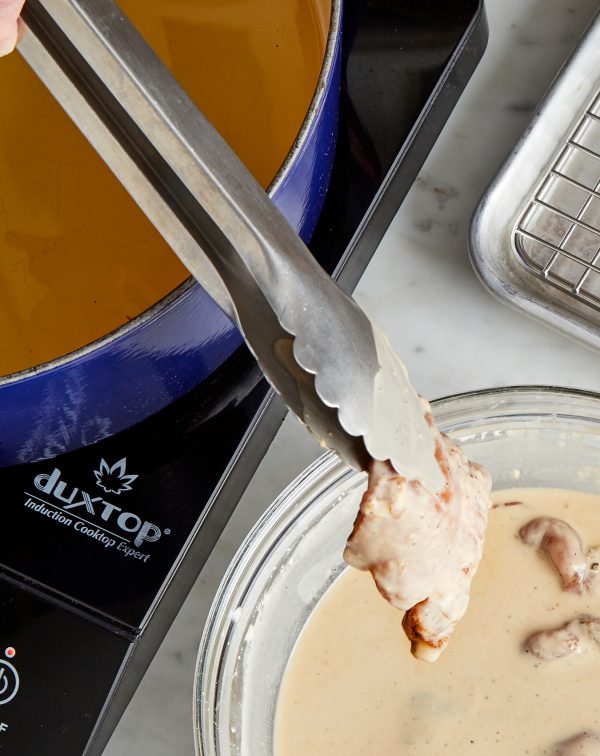
4. Remove the chicken from the slurry and fry in 350°F oil for 2 minutes. Repeat with the remaining chicken in 2 batches.
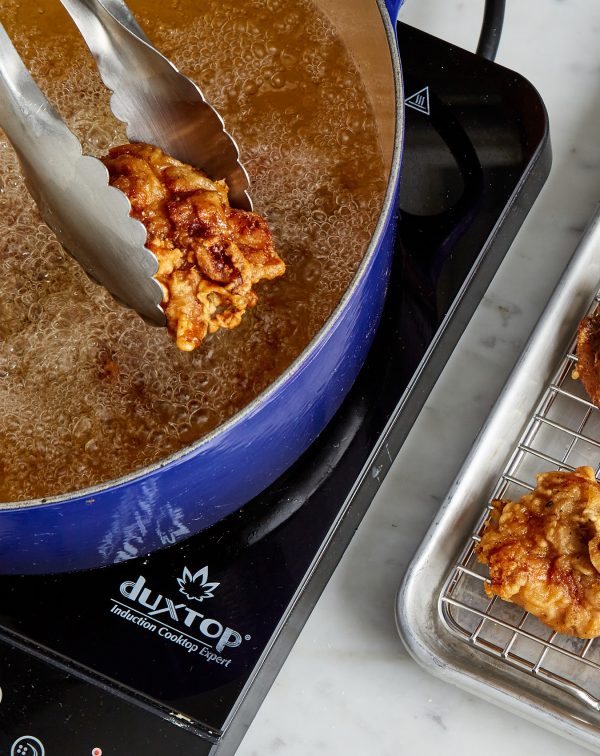
5. Divide the fried chicken into two batches and fry each again for 2 to 3 minutes, or until golden brown.
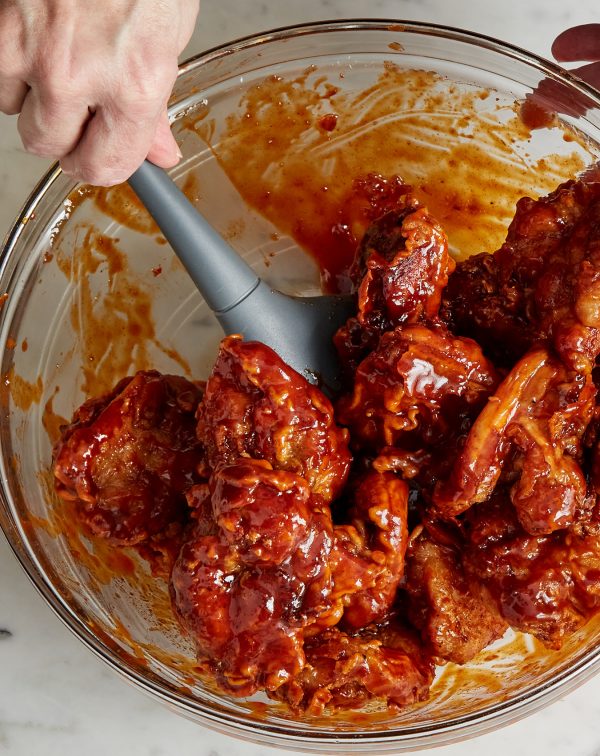
6. Transfer the hot chicken to the sauce mixture in a large bowl. Toss until the chicken is evenly coated.
Related Recipes
May - June 2023

Sign up to receive texts
Successfully signed up to receive texts!
We'll only send our very best offers - Like a $15 store credit to start.
By entering your phone number and submitting this form, you consent to receive marketing text messages (such as promotion codes and cart reminders) from Christopher Kimball's Milk Street at the number provided, including messages sent by autodialer. Consent is not a condition of any purchase. Message and data rates may apply. Message frequency varies. You can unsubscribe at any time by replying STOP or clicking the unsubscribe link (where available) in one of our messages. View our Privacy Policy and Terms of Service.
